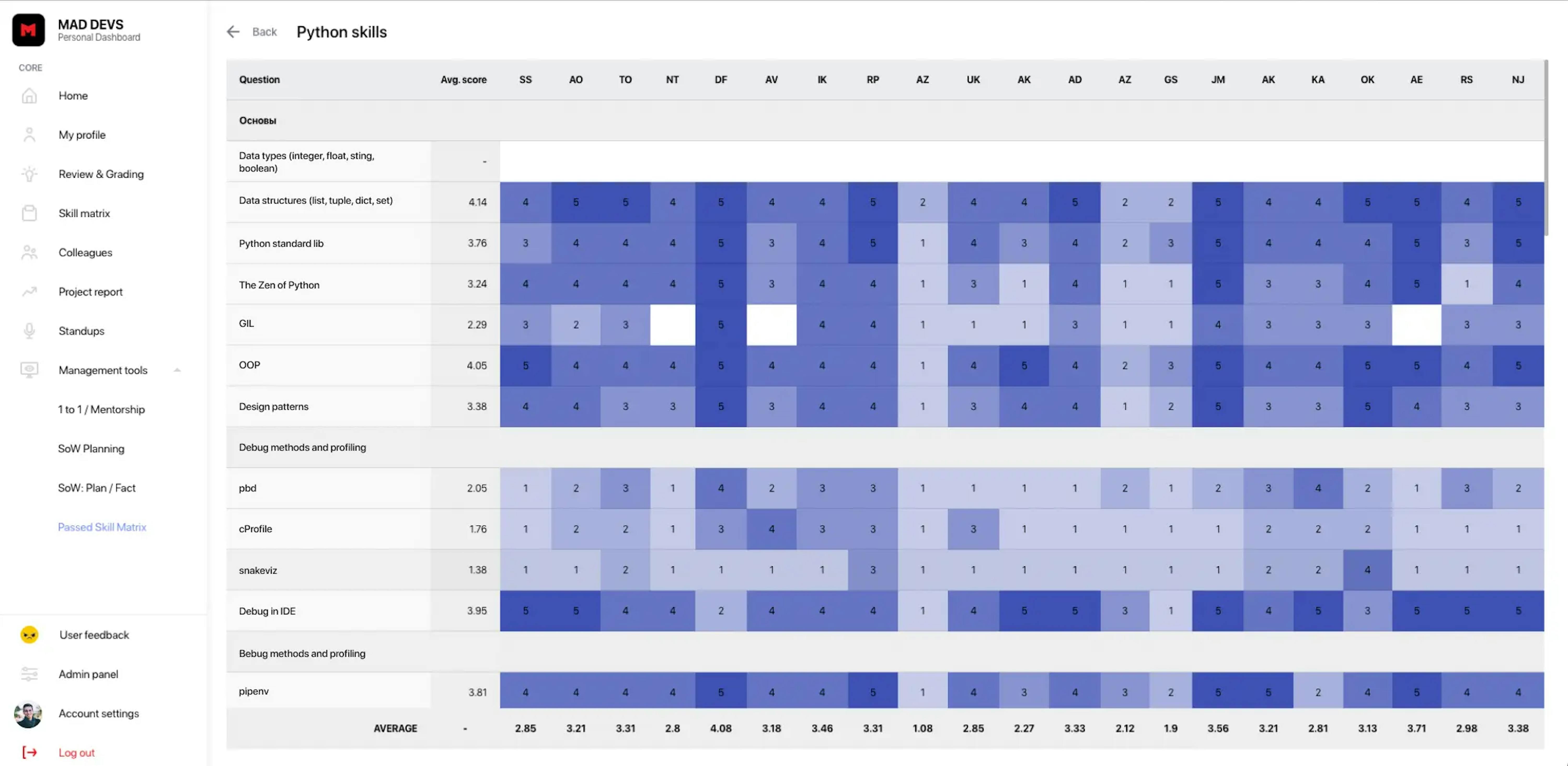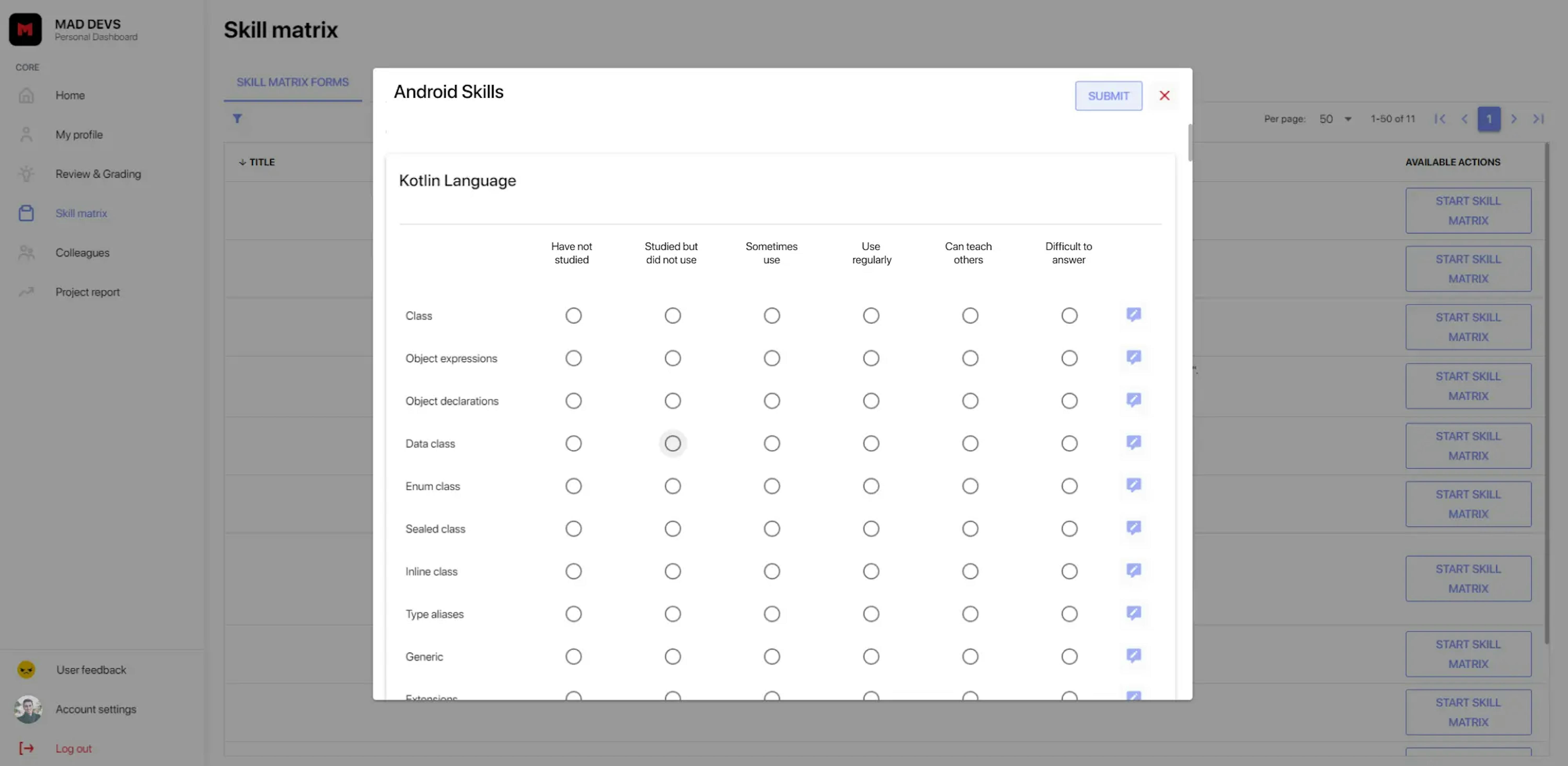Are you looking for a way to measure the skills of your workforce, identify areas for improvement, and make more informed decisions about training and development? A skill matrix is a useful tool that can help you do this. In this article, we will explore a skill matrix, the benefits of a skill matrix for employees, managers, and organizations, and the steps for creating and updating a skill matrix. Most importantly, we will share our experience and tell you why and how we decided to create our own skill matrices. To give you a complete picture, we will also share our expertise working with them and what tools we use.
What is a skills matrix?
The skills matrix is a tool used to assess an employee's skills and abilities for a particular role or project. It is also known as a competency matrix. The hiring team and human resources typically develop the skills matrix.
Generally, the skill matrix is a visual representation of each employee’s qualifications and knowledge in relation to specific job functions. Inside our company, we have already developed the technical skill matrix, soft skill matrix for developers, and skill matrix for DevOps engineers.
What is a Mad Devs' skills matrix?
Work on skill matrices started about 1,5 years ago. At first, we tried to work with ready-made ones, but over time we realized that market skill matrices do not fully match our understanding and vision. The market skill matrix demonstrates something average and can be interpreted differently. We needed a solution optimized for us. Therefore, we looked at the available developments and adapted the market parameters for our teams.
We could not ignore the market but also needed to create matrices that met our needs. In the first stages, we formed matrices for the main technical stacks. Over time, we understood that the engineering skill matrix should stand apart from others because it is transferable expertise. In addition, the soft skill matrix should also stand alone.
To begin with, we defined for ourselves the reasons why we need our own skill matrix:
Mad Devs is one of the fastest-growing companies in the market. And at some point, the staff was intensively recruited, in large volumes and in a short period of time. We believe that a Mad Developer should be very versatile in and of itself.
Due to the rapid growth of the staff, we needed to have the opportunity to measure whether each employee fitted to not a particular role in a local project or department but also fulfilled requirements to move across different projects with various needs within the company. To measure this, we needed special tools that would allow us to understand what kind of people we work with.
Main purposes why we use skill matrices:
- To determine what a person is able to do.
- Determine the drawdown of a person's knowledge relative to other guys within the same stack skills in one area.
We use skill matrices to identify strengths and weaknesses within a particular job role and provide a way to measure and compare the skills of various job candidates. The skill matrix typically includes a variety of skills and competencies related to the job role, and employees can be evaluated on each of these skills.
In addition, we have defined goals for skill matrices:
- Determine the level of expertise of an employee
- Find out the employee's area of expertise outside of local project or department requirements.
For what? We believe that skill matrices only give a picture. What matters is how you interpret it. For example, opinion leaders, if they see drawdowns, they see these as issues that need to be worked on. Stakeholders determine that if an important project comes to them, they will look to a team of people with above-average skills and experience. This is particularly beneficial if multiple team members with different job roles require different levels of training.
If we want to start working in a specific area, we can use skill matrices to check the level of our staff. Because we need to answer the following questions:
- How much expertise do we have?
- How much do we need to dig?
- Do we need to hire experts?
- Can we finish our studies ourselves?
But it is also important how you handle the information received.
What tools do we use?
When we started working on our skill matrices, we tried to find a convenient tool. At first, we worked with Miro, but analyzing the data and collecting information became inconvenient as more people came. Next, we tried to work with Google Spreadsheets. Unfortunately, this instrument didn't fit us either because questions immediately arose as to how to account for and maintain a bunch of documents and regulate access to them.
So, we decided not to think twice and asked our team members from Enji.ai. They exported the existing skill matrices from the Spreadsheets and imported them to Enji.ai. Thus, our employees can easily take the test from their personal accounts, and PMs and CTO can request information from Enji.ai at any time.
Recently new features were added to Enji.ai, so it was made possible to pass skill matrices, and after the team passes the questionnaire, PM, for example, can see all the data in the heatmap. Currently, we can use the collected information to see skills gaps and areas of development and work it through the community. Or, according to the data, we can assemble a team for a project with one or another technological stack.

Now it is possible to make our teams more productive:
- Create a team of skilled and qualified employees;
- Find out if there are any skill gaps in the company;
- Identify skills and competencies for future upskilling;
- Avoid vertical career progression;
- Keep track of employee trends and improvements;
- Provide employees with targeted training.
If you want such an experience, you can learn more on Enji's official website or contact us and book a call where we answer your questions.
Now Enji.ai is a good way to work with skill matrices and conveniently store and process information. However, we strive to expand the functionality, and in the near future, more new features will appear.
Using a skills matrix in Enji.ai
As we mentioned above, a skills matrix is a tool used to assess the skills and competencies of an individual or team. It is often used to identify strengths or weaknesses and to determine the training or development needs of the team or team members. So skill matrix can be used for planning continuous improvements and regular training of employees. Note, distinguish the skill matrix from grading since the skill matrix is one of the tools for evaluating an employee.
There are several ways depending on the interpretation of the performance review results. Inside Mad Devs, we created a special system for working with skill matrices. We are using them for training purposes to help improve training effectiveness for our employees. Thus, it becomes easier to get an overall picture of the knowledge of employees. In addition, teams see which specialists are missing and can turn to HR for help.
In addition, skill matrices help us understand whether we are ready to work in a specific area if such a need arises. That is, we can pre-check the level of knowledge of our staff because we need to know what level of expertise our employees have and whether we can do it without outsourcing or finishing our studies ourselves.
Benefits of a skills matrix
A skills matrix visualizes an individual's knowledge, skills, and abilities, allowing employers and managers to identify strengths and weaknesses. The matrix also provides a way to compare team members against each other, making it easier to assign tasks based on each person's capabilities.
- For employees, a skills matrix is a great way to understand their personal abilities and strengths. It can help them identify areas for improvement and spheres they are excellent in. It also provides a way to track their progress as they learn new and enhance existing skills. A skills matrix also helps employees better understand their roles and how their skills fit into the bigger picture.
- For managers, a skills matrix is a valuable tool for assessing team performance. It can identify individual and team strengths and weaknesses, enabling managers to allocate tasks and resources more effectively. It can also be used to assess the impact of training and development initiatives, allowing managers to measure the effectiveness of their efforts. A skills matrix also provides a way to track the performance of individual team members over time, making it easier to identify areas for improvement.
- For organizations, a skills matrix can be a powerful tool for driving organizational performance. It can be used to identify and target areas for improvement, enabling organizations to develop and implement targeted strategies for improvement. It can also benchmark the organization against competitors, ensuring it remains competitive in the market. A skills matrix can also be used to identify potential areas for new hires and to assess the impact of organizational changes on team performance.
Disadvantages of a skills matrix
A skills matrix is a great tool for employers wanting to understand their developers' and engineers' skills and competencies. However, there are some pitfalls to using a skills matrix.
- One of the main disadvantages is how a skills matrix can lead to oversimplification. It can be difficult to capture the nuances of a particular skill or competency with a simple rating system.
- Additionally, a skills matrix can be difficult to maintain and update. The matrix must be updated to reflect this as skills and competencies change.
- Moreover, there is a diversity of opinions among developers about certain disciplines. To avoid misunderstandings within the team, we had to write in detail all the questions and descriptions of how to pass the matrix, and what it measures.
- Besides, the skill matrix is just numbers. Therefore, it is easy to misinterpret them since someone can highly appreciate their knowledge, someone vice versa. To avoid such confusion, we at Mad Devs reinforce the opinion about the employee through feedback from the community, project managers, and teammates.
- Finally, a skills matrix can take time to interpret. A rating of 3 out of 5 may mean something different to one person than another, making it difficult to get the full picture of each team member's skills and competencies.

An alternative to a skills matrix is to use a more descriptive approach to capture the skills and competencies of each team member. This could include a brief description of each skill or competency as well as more detailed comments. However, this can take more time and effort to maintain and update, so weighing the pros and cons of each approach is essential.
It is essential to understand the benefits and flaws of a skills matrix when determining the best approach for assessing your developers' and DevOps engineers' skills and competencies. While a skills matrix can provide a quick snapshot of the team's technical and soft skills, it has the mentioned disadvantages, which need to be worked out. So skill matrices should be used with the necessary care and reason.
Conclusion
A skills matrix is a powerful tool for employees, managers, and organizations alike. It offers an easy way to track, measure, and develop skills, as well as facilitate training, development, and performance assessments. With the right approach, a skill matrix can provide invaluable insights into the skills of your team and help you create a comprehensive and effective training plan.
Key ideas of this article
- Skill matrices need to be constantly updated to keep them up to date with current technologies.
- The main way to get insight into the current state of your team is through regular, high-quality performance reviews.
- Despite the differences in approaches, software developers and managers should adhere to the same methodology and logic.
- Keep track of your team's performance in the past and emphasize its progress.
- Analyzing your performance review results will vary based on each case, but keep your goals in mind.











